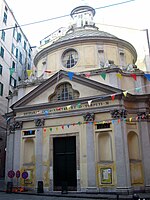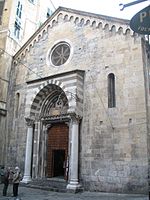Oratory of San Giacomo della Marina

The Oratorio di San Giacomo della Marina (translated as Oratory of St. James of the Marina) is a small chapel or prayer-house at the dockside in Genoa, northern Italy. Erected in 1453, the oratory was rebuilt and decorated in the 17th century. Twelve large canvasses illustrating the saint and patron of the battle against the Moors, Saint James, were completed by major Genoese Baroque artists including: Giovanni Benedetto Castiglione (il Grechetto) - St. James defeats the Moors Giovanni Battista Carlone - St. James Opens the Gates of Coimbra to King Ferdinand and Martyrdom of St. James Valerio Castello - Saint Peter Baptizes St. James Giovanni Domenico Cappellino - St. James Preaching Domenico Piola Martyrdom of the Saint Giovanni Lorenzo Bertolotto - The Invention of the Spoglia Aurelio Lomi - Sons of Zebedee with JesusThe exterior of the oratory is unadorned. The confraternity was active in religious processions during past centuries.
Excerpt from the Wikipedia article Oratory of San Giacomo della Marina (License: CC BY-SA 3.0, Authors, Images).Oratory of San Giacomo della Marina
Mura delle Grazie, Genoa Centro Est
Geographical coordinates (GPS) Address External links Nearby Places Show on map
Geographical coordinates (GPS)
| Latitude | Longitude |
|---|---|
| N 44.405277777778 ° | E 8.9286111111111 ° |
Address
Oratorio di San Giacomo della Marina
Mura delle Grazie
16123 Genoa, Centro Est
Liguria, Italy
Open on Google Maps











